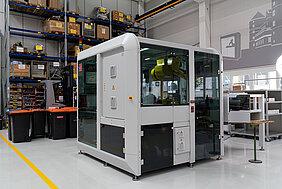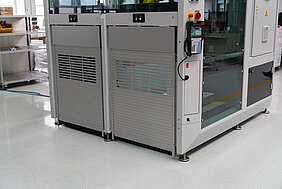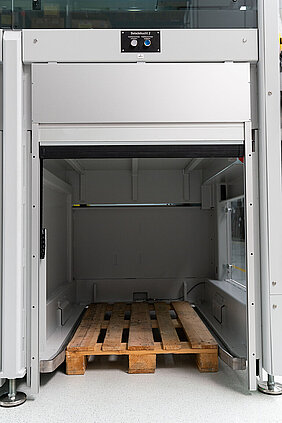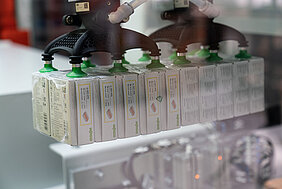Simply on the pallet - Scalable palletizing cell for WAGO
At some point, the work at a palletizing station will become too difficult for employees, provided that someone can be found for the strenuous job at all. A robot can help.
HandlingTech has implemented a palletizing cell based on the SRZ platform in the Sondershausen production and logistics center of WAGO, a global manufacturer of electrical components and automation technology. Already largely automated in production and assembly, the "automation gap" in palletizing has now been closed with the cell.
The initial situation: Products coming from assembly, already packed in boxes, were each packed in packs of 2x5 boxes - but with two different sizes of the individual boxes and thus two container sizes - in shrink film and then arrived on a roller conveyor to the palletizing area, where an employee was waiting to place the packs on a pallet.
The situation today: The packs come via the first of a total of three roller conveyors to an SRZ robot cell from HandlingTech, which then palletizes them fully automatically. Lane 2 is intended for further expansion and lane 3 is used both for manual removal and for NOK ejection. The shrink tunnel has a transverse slide and pushes the packs onto the respective roller conveyor as required. Important for the operator: All employees remain active in the automated area - albeit relieved of strenuous activities and with new tasks.
A FANUC robot of the type M-710iC with a payload of 50 kg and a reach of 2,050 mm works in the cell. The robot is equipped with a double suction pad, where the vacuum can be controlled separately. Two packs are gripped with the gripper and only one if at the end of a palletizing layer one more pack has to be “filled up”. Bastian Willim, technology consultant at HandlingTech, supervised the system during the implementation phase: "Everyone involved worked closely and cooperatively during the implementation, including individual requests."
Safe bays
There are two pallet bays in the cell for receiving Euro pallets. If a pallet is full, a bulkhead moves over the pallet and covers it from above. The roller door of the respective pallet bay can only be opened once this protection has been achieved. The pallet can then be pulled out of the box using a hand pallet truck. Willim: "The next logical step would be to have the pallet picked up by an AGV. We can also support such a solution.”
Thanks to the separating bulkhead, the robot can continue to work in compliance with CE while the pallet is being driven out of the station - regardless of whether the pallet is picked up manually or automatically.
Proven and duplicated
The palletizing station can certainly serve as a blueprint for other cells of this type. "That applies to both sides, both for the customer and for us," Bastian Willim sees in this project as groundbreaking cornerstones. Because one thing is likely to return in many projects in the future: the subsequent automation of a manual palletizing station. Typical, and not only for this project, is the specified available space: "It is always important to have the smallest possible footprint." Nevertheless, the palletizing capacity must always be a little ahead of the system capacity so that the palletizing cell does not become a bottleneck in terms of throughput. In this case, the HandlingTech experts even managed to exceed the required performance by 20%. So there is still room for improvement.
With the current throughput, the robot is not yet at its performance limit. The moderate speed benefits availability and overall service life. In addition, the vacuum grippers must also hold the container securely. If even higher performance is then required in practice, mechanical support for the gripper could be worth considering, for example.
The design of the gripper is also tricky: In order to have the greatest possible security and at the same time be flexible when gripping a smaller number of boxes, a double gripper with six suction cups each was provided. Depending on the carton size, different packing patterns can be set. In addition, the container sizes can vary depending on the product, but the pallets are always sorted according to type. Since you can control both suction pads individually, the consumption of suction air is kept within limits.
The packing patterns are set automatically. They are stored in the system control for each product. Since different container sizes run through the system, only mechanical stops have to be adjusted. This can be done without tools. The operator logs on to the cell with a coded chip and starts the new program on the robot's control panel. This makes operating the system easy and clear.
Overall, it was beneficial that the WAGO project planning team, with its extensive experience in the automation of production systems, was actively involved. "The cooperation with the customer was definitely extremely good," praises Bastian Willim.



